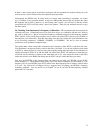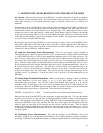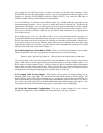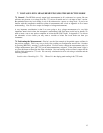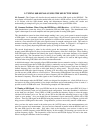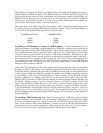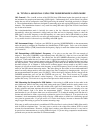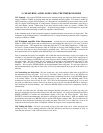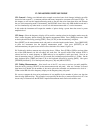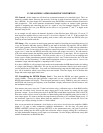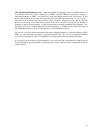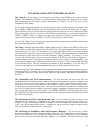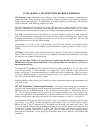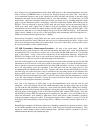20
11. MEASURING AUDIO NOISE USING THE WIDEBAND MODE
11.1 General – All versions HP3586 can be used to measure total power input over their entire frequency
range of 200Hz to 32MHz by placing them into the wideband measuring mode. This mode is useful for
rapidly measuring a signal whose frequency isn’t important or is determined by tuned circuits like in an IF
stage as a digital wide band power or voltage meter. However, in this mode the instrument’s noise floor is
very much higher, around –70dbm, than in the other selective modes where it’s around –120dbm. This
could cause errors in measuring weak signals. In the following example we will illustrate how to use the
wideband mode when measuring an audio line amplifier’s internal noise.
In the wideband mode all the front panel frequency dependent displays and controls are deactivated. The
instrument in the wideband mode is a broadband power or voltage measuring instrument with a frequency
response of 200Hz to 32MHz.
11.2 Wideband Amplifier Noise Measurement – Assume we have an amplifier that we can input
200Hz to 10KHz audio signals from an audio device to and amplify this signal up to a 2.5 watts 75 ohm of
audio output power. This amplifier has a 600 ohm input and a 75 ohm output impedances, a 20db gain,
and it uses a socket mounted inexpensive audio IC chip that we can buy from different sources. We want
to select the chip that has the lowest internally generated noise. We’ll use our HP3586 to measure the
noise performance of our amplifier with different chips in its wideband measurement mode.
First we terminate the input of our amplifier with a 600 ohm resistor and attach a scope to its output to be
sure there is only internal noise generated by the amp from its output. Any of signals with a total power of
over .5 watts will damage out HP3586 so we want to be sure there is nothing but low power white noise on
the amps output. We now connect the AC coupled 75 ohm output to the termination sub panel 75 ohm
connector. We next press [75 ohm] on the termination sub panel to provide a 75 ohm load for our
amplifier. We next press [WIDE BAND] on the measurement mode sub panel. We also press [dbm] on
the measurement/entry sub panel for units since we’ll start by measuring the noise power in db relative to a
miliwatt.
11.3 Normalizing our Noise Data - We now should see a low level reading in dbm units on the LED of
the measurement entry sub panel. Let’s say its –50.1dbm, which is about as low as our HP3586 can
accurately measure in the wideband mode since the internal wideband noise floor on my HP3586B appears
to be around 70dbm. Also the 100db measuring range is only available in the wideband mode so the
resolution of our level data will only be .1db. We’ll now let the instrument compare the IC’s for us and
also pick up a little more accuracy since we are down so low in power level that the HP3586 is starting to
loose accuracy for absolute readings. Let’s offset the HP3586 display to read in db’s compared to our first
standard chip.
To do this we could enter the –50.1dbm offset using the keyboard, but there is an easier way using one
button to transfer the displayed offset directly into the offset register. Go to the entry keyboard and press
[RDNG→OFFSET] to transfer the measurement display’s level into the offset register. Now press
[OFFSET] on the measurement/entry sub panel to activate the level offset feature. With our amplifier still
powered and connected to our HP3586 we now see the LED display reading is 0db. We also should see O
behind the dbm annunciator indicating the reading has been offset and is not in dbm but is now in db
compared to the noise power from our amplifier with the IC chip we want to compare the others to.
11.4 Taking the Data – We now can proceed to plug in the other chips one at a time and record db
readings for each. We see readings between +15db and –6db above and below our reference IC chip. It
looks like the one that is –6db is the best choice for low noise.



